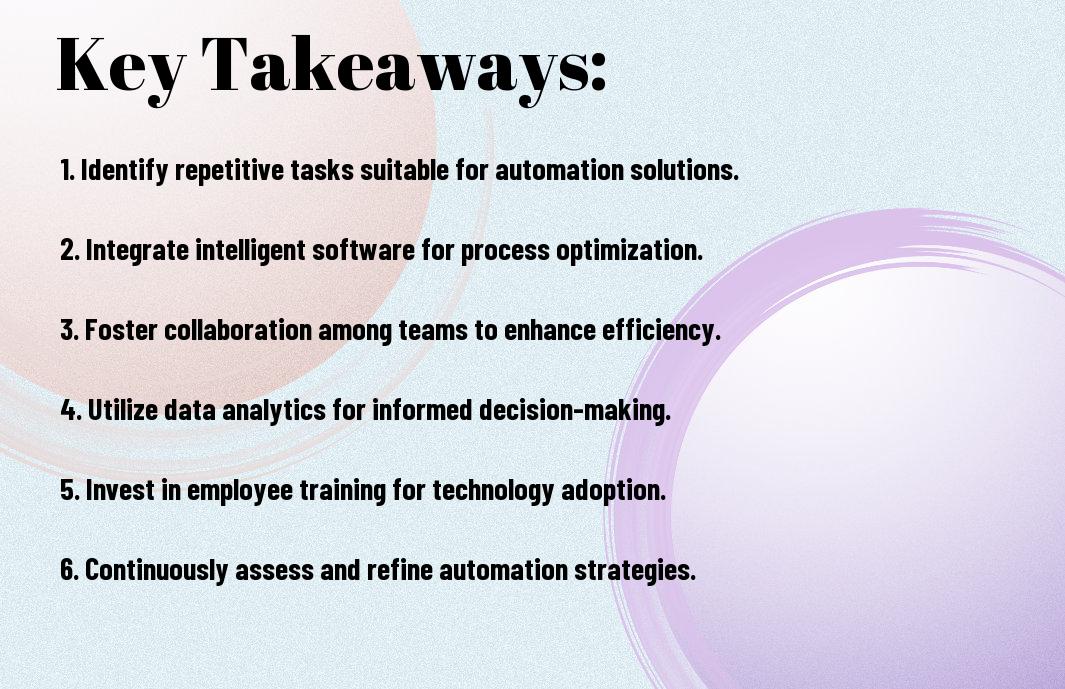Business automation can significantly enhance your operational efficiency and streamline your processes. In this blog post, you will explore six key strategies that can help you implement automation effectively, allowing your organization to save time, reduce costs, and improve productivity. By adopting these strategies, you can leverage technology to create a more agile and responsive business environment that meets your goals and adapts to changing market demands.
Key Takeaways:
- Identify key areas within the organization that can benefit most from automation to maximize efficiency.
- Leverage data analytics to inform automation decisions, ensuring that solutions are tailored to meet specific business needs.
- Invest in training and development for employees to facilitate a smooth transition to automated processes.
- Integrate automation tools with existing systems to enhance interoperability and reduce operational silos.
- Continuously evaluate and refine automation strategies to keep pace with technological advancements and changing market demands.

Understanding Automation in Business
A pivotal aspect of modern business, automation enhances efficiency and productivity across various operations. By leveraging technology, you can implement systems that streamline processes, reduce human error, and increase overall output. To learn more about how to elevate your business practices, check out these 6 must-know small business automation strategies.
Definition of Business Automation
Definition of business automation refers to the use of technology to perform repetitive tasks, allowing you to focus on more strategic initiatives. This encompasses a wide range of activities including data entry, customer communication, and inventory management, making your operations more seamless.
Benefits of Automation
Between enhanced efficiency and cost savings, automation can transform your business landscape significantly. By automating mundane tasks, you free up valuable time for your team to concentrate on core business objectives that drive growth and innovation.
In addition to efficiency, automation also minimizes errors and enhances consistency across your operations. As a result, you can expect improved accuracy in tasks, leading to better decision-making and higher customer satisfaction. Enhanced reporting capabilities through automation also provide you with clearer insights, allowing for more informed strategies and improved performance metrics.
Key Strategy 1: Streamlining Processes
Some businesses struggle with inefficiencies that hinder their potential for growth. By streamlining processes, you can enhance productivity and boost your overall performance. This involves analyzing your current operations to identify areas for improvement and implementing automated solutions that save time and reduce errors. Embracing this strategy allows you to focus on higher-value tasks while your systems manage routine operations effectively.
Identifying Inefficiencies
One effective way to streamline your processes is by identifying inefficiencies within your current workflows. Start by evaluating each step in your daily operations and pinpoint tasks that take longer than necessary, require excessive manual input, or contribute little value. Gathering insights from your team can also uncover hidden bottlenecks and areas where automation can make a significant impact on productivity.
Implementing Workflow Automation
Streamlining your processes often leads to implementing workflow automation to simplify repetitive tasks. Automated systems can help you improve accuracy and efficiency by handling mundane duties, allowing your team to dedicate more time to strategic and creative efforts. As you transition to automated workflows, you’ll notice enhanced collaboration, minimized errors, and the ability to focus resources on driving your business forward.
It is important to carefully choose the right tools for automation that align with your business needs. Start small, selecting specific tasks or processes that can transition smoothly to automation. By regularly reviewing the performance of your automated workflows, you can make adjustments that reflect changes in your business environment. Over time, as you expand automation across various functions, your organization will be better equipped to respond quickly to market demands, ultimately leading to growth and innovation.
Key Strategy 2: Integrating Technology
All businesses can significantly enhance their operations by integrating technology into their workflows. This involves identifying and implementing software and hardware solutions that align with your business needs. Leveraging automation tools can streamline processes, improve communication, and boost productivity, ultimately leading to a more efficient operation.
Choosing the Right Tools
Along your journey to automation, selecting the right tools is necessary. You should focus on software that caters specifically to your operational requirements. Research various options, read user reviews, and seek recommendations to find tools that fit seamlessly into your existing processes.
Ensuring Compatibility and Scalability
With the ever-evolving business landscape, ensuring your technology choices are compatible and scalable is vital. This means selecting solutions that will grow alongside your business without causing disruption to your current operations.
This consideration is fundamental as it helps you avoid costly replacements and rework in the future. You want to adopt tools that can integrate with your existing systems and expand their capabilities as your business scales. Conduct thorough research on how different technologies interact with each other and invest in platforms that allow for easy upgrades or additional features, ensuring your automation infrastructure remains robust and effective over time.

Key Strategy 3: Leveraging Data Analytics
Keep in mind that leveraging data analytics can significantly enhance your business operations. By harnessing the power of data, you can make informed decisions that streamline processes, boost efficiency, and ultimately improve profitability. Utilizing advanced analytics tools enables you to uncover patterns and insights that were previously hidden, setting the stage for your organization to thrive in a competitive landscape.
Understanding Data-Driven Decision Making
Any successful business strategy today hinges on data-driven decision-making. This methodology empowers you to analyze real-time data, allowing you to predict trends, understand customer preferences, and make choices that align with your business goals. By integrating data into your workflow, you can foster a culture of evidence-based decision-making that enhances your overall strategy and performance.
Utilizing Analytics for Optimization
Any business aiming for success must utilize analytics for optimization. This approach helps you identify inefficiencies within your operations and setting the stage for continuous improvement. Through analyzing key performance indicators (KPIs) and customer feedback, you can fine-tune processes, tailor offerings, and ultimately enhance your competitive advantage.
In fact, by utilizing analytics for optimization, you can drive impactful changes across your organization. Implementing these insights helps you allocate resources more efficiently, reduce operational costs, and improve customer satisfaction. As a result, your business becomes more agile and responsive to market demands, ensuring you remain ahead of the curve and in alignment with your customers’ evolving needs.
Key Strategy 4: Employee Training and Engagement
Your workforce is the backbone of your business, and effective employee training and engagement are vital to enhancing automation practices. By investing in your employees’ development, you not only improve their skills but also foster a culture of adaptability, ensuring your team can leverage new automated processes with confidence.
Importance of Workforce Buy-In
Strategy is simpler when your employees feel invested in the transition to automation. Gaining their buy-in helps eliminate resistance and promotes enthusiasm around new technologies. Engaged employees are more likely to embrace automation initiatives and contribute to their success, creating a supportive environment for continuous improvement.
Training Programs for Skill Enhancement
By implementing tailored training programs, you empower your employees with the skills needed to navigate automated systems effectively. This enhances their job satisfaction and performance, directly benefiting your business’s growth.
With comprehensive training programs, you can ensure that employees gain the technical proficiency necessary to work alongside automation tools. These programs can include hands-on workshops, online courses, and mentorship opportunities, enabling your workforce to adapt efficiently to new technologies. Investing in continual skill enhancement not only uplifts individual performance but also strengthens your overall workforce, fostering collaboration and innovation within your organization.

Key Strategy 5: Customer Experience Automation
Now is the time to focus on customer experience automation, as it can enhance engagement and streamline interactions across your business. Implementing automated solutions not only saves time but also allows you to provide a seamless service. By leveraging technology to anticipate your customers’ needs, you improve satisfaction and loyalty, which are important for long-term success.
Enhancing Customer Interaction
On many occasions, customers seek instant responses and personalized engagement. By automating interactions, you can ensure that your brand is always available, creating a positive experience. Utilizing technology allows you to respond to inquiries in real time while freeing up your team’s resources for more complex tasks that require human intervention.
Utilizing Chatbots and CRM Systems
On your journey to automate customer experience, integrating chatbots and CRM systems is highly beneficial. Chatbots can handle common queries efficiently, while CRM systems help you collect and analyze customer data to enhance service delivery.
Understanding how to effectively utilize chatbots and CRM systems can significantly elevate your customer interactions. Chatbots serve as the first point of contact, addressing customer inquiries instantly and ensuring they feel heard. Meanwhile, a CRM system tracks customer history and preferences, allowing you to tailor future communications and offers. By combining these tools, you not only enhance efficiency but also create a more personalized experience that resonates with your audience.
Final Words
From above, you can see how leveraging the six key strategies can significantly enhance automation in your business. By identifying the right processes, investing in technology, and fostering a culture of innovation, you position yourself to streamline operations and drive efficiency. Embracing these strategies not only saves time and resources but also empowers your team to focus on more impactful tasks. As you implement these strategies, your business can adapt and thrive in an ever-evolving landscape.
FAQ
Q1: What are the six key strategies to boost automation in business?
A: The six key strategies for enhancing automation in business include: 1) Process mapping, 2) Prioritizing tasks for automation, 3) Investing in the right technology, 4) Fostering a culture of automation, 5) Continuous monitoring and optimization, and 6) Training and support for employees. Each of these strategies helps organizations identify opportunities for automation and implement solutions efficiently.
Q2: How can process mapping help in boosting automation?
A: Process mapping involves visualizing workflows to identify inefficiencies and areas suitable for automation. By breaking down each task step-by-step, businesses can pinpoint repetitive manual tasks that consume time and resources. This clarity allows for strategic automation solutions to be implemented, leading to streamlined operations.
Q3: Why is prioritizing tasks important for effective automation?
A: Prioritizing tasks ensures that businesses focus on automating the most impactful processes first. By assessing which tasks take up the most time or resources, organizations can allocate their automation efforts efficiently, maximizing returns. This strategic approach can lead to quicker wins and more effective use of automation technologies.
Q4: What role does technology investment play in automation?
A: Investing in the right technology is central to successful automation. It ensures businesses have tools that fit their specific needs and workflows. This may include software solutions, robotic process automation (RPA), or machine learning tools that facilitate automation. Choosing the right technology can enable seamless integration with existing systems, resulting in a smoother transition to automated processes.
Q5: How can a culture of automation benefit a business?
A: Fostering a culture of automation encourages employees to embrace new technologies and processes. When employees understand the benefits of automation and are involved in the implementation, they are more likely to adopt changes positively. This inclusive approach helps to minimize resistance to automation and enhances collaboration across teams.
Q6: What is the importance of continuous monitoring and optimization in automation?
A: Continuous monitoring and optimization are necessary to ensure that automated processes are functioning at their best. By regularly reviewing performance metrics and workflow efficiency, businesses can identify areas that may require adjustments or improvements. This proactive approach helps in maintaining productivity and can alleviate any potential issues that arise from automation over time.
Q7: How can training and support for employees enhance automation efforts?
A: Providing training and support equips employees with the skills needed to effectively utilize automated systems. It also helps to alleviate any apprehension they may have about new technologies. Ensuring that employees are comfortable and knowledgeable about automation tools maximizes efficiency and promotes a more productive workforce that is adaptable to change.



